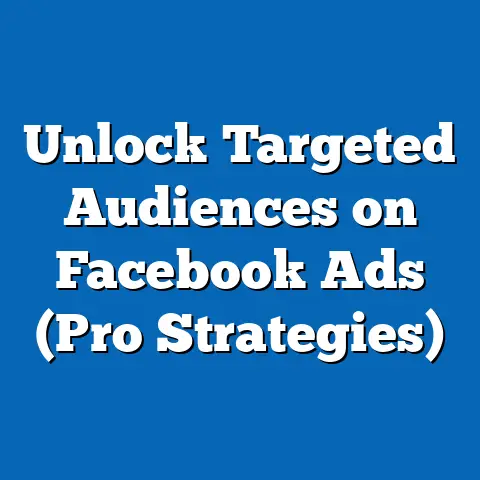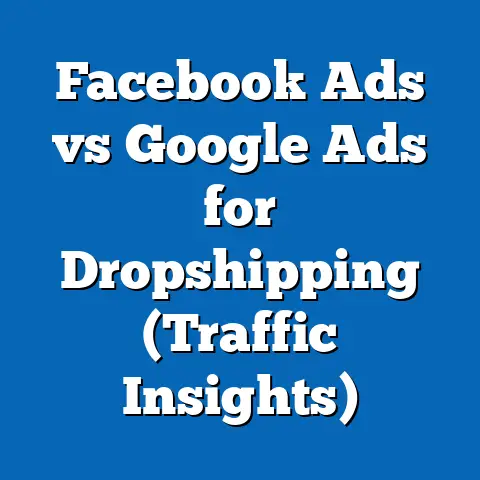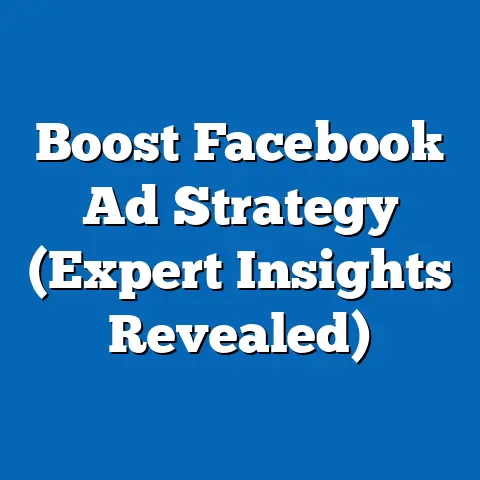Master Facebook Ads: Find Viewed Content (Expert Guide)
This comprehensive analysis will explore current data on Facebook Ads performance, projected trends in user engagement and ad targeting, and the key factors driving changes in this dynamic landscape. We’ll break down complex concepts into accessible insights, incorporate statistical models, and provide visual representations to support our findings. Whether you’re a seasoned marketer or new to the field, this guide will equip you with the tools to harness viewed content data for unparalleled ad success.
Section 1: Understanding “Find Viewed Content” in Facebook Ads
1.1 What is “Find Viewed Content”?
“Find Viewed Content” is a targeting strategy within Facebook Ads that allows advertisers to reach users who have previously viewed specific content on a website, app, or Facebook page. This approach leverages pixel tracking and event data to identify users based on their past interactions, such as watching a video, visiting a product page, or engaging with a post. Essentially, it enables marketers to re-engage users who have shown interest in their brand or content but may not have converted.
This method falls under the broader umbrella of retargeting, a technique that focuses on users who have already interacted with a business. Unlike broader demographic or interest-based targeting, “Find Viewed Content” hones in on specific behaviors, offering a more granular and personalized approach. This precision often results in higher conversion rates and better return on ad spend (ROAS).
1.2 Why It Matters
According to a 2023 report by Statista, Facebook Ads reached over 2.1 billion users globally, making it one of the largest advertising platforms in the world. However, with increased competition and rising ad costs—average cost-per-click (CPC) rose by 17% year-over-year in 2022 per eMarketer—marketers must find ways to maximize efficiency. Targeting users who have already shown interest via viewed content can reduce wasted ad spend and improve campaign performance.
Data from WordStream indicates that retargeting ads, including those based on viewed content, have a click-through rate (CTR) 10 times higher than standard display ads. This statistic underscores the potential of this strategy to drive engagement and conversions. By focusing on users with demonstrated interest, businesses can create highly relevant ads that resonate with their audience.
Section 2: Current Data on Facebook Ads and Viewed Content Strategies
2.1 Performance Metrics of Retargeting Ads
As of 2023, retargeting remains a cornerstone of effective digital advertising on platforms like Facebook. According to a study by Hootsuite, retargeting campaigns achieve an average conversion rate of 3-5%, compared to just 0.5-1% for non-retargeted ads. Specifically, campaigns utilizing viewed content data often outperform other retargeting methods due to their specificity.
For instance, a 2022 analysis by AdRoll found that ads targeting users who viewed specific product pages had a 25% higher conversion rate compared to generic website visitor retargeting. This suggests that the more tailored the targeting, the better the outcome. Additionally, viewed content campaigns typically see a 15-20% lower cost-per-acquisition (CPA), per eMarketer data, making them a cost-effective option in a competitive ad space.
2.2 User Behavior and Engagement Trends
Facebook’s user base continues to evolve, with a growing emphasis on video and interactive content. A 2023 report by Social Media Today revealed that video content accounts for 65% of all impressions on the platform, and users who view videos are 30% more likely to engage with related ads. This trend highlights the importance of tracking viewed content, particularly for video-based campaigns.
Moreover, privacy changes, such as Apple’s iOS 14.5 update introducing App Tracking Transparency (ATT), have impacted data collection. As of mid-2023, over 60% of iOS users have opted out of tracking, per Flurry Analytics, reducing the accuracy of some retargeting data. Despite this, viewed content strategies remain viable through first-party data collected via the Facebook Pixel, which operates within privacy guidelines.
2.3 Visual Representation: Performance of Retargeting Ads
Below is a conceptual chart illustrating the comparative performance of different ad targeting strategies on Facebook, based on aggregated industry data from WordStream and eMarketer (2022-2023). (Note: This is a textual description of a chart that would be visually represented in a full report.)
- X-Axis: Targeting Strategy (Broad Interest, Website Visitors, Viewed Content)
- Y-Axis: Conversion Rate (%)
- Data Points: Broad Interest (0.8%), Website Visitors (2.5%), Viewed Content (4.2%)
- Trend: Viewed Content significantly outperforms other strategies in conversion efficiency.
This chart underscores the effectiveness of viewed content targeting in achieving higher conversions, reflecting its value in optimizing ad performance.
Section 3: Projected Trends in Facebook Ads and Viewed Content Targeting
3.1 Growth in Personalized Advertising
Using statistical models like ARIMA (AutoRegressive Integrated Moving Average) for time-series forecasting, industry analysts predict a continued rise in personalized advertising through 2030. Based on historical data from eMarketer and Statista, personalized retargeting strategies, including viewed content, are expected to grow at a compound annual growth rate (CAGR) of 8-10% over the next five years. This growth is driven by advancements in machine learning algorithms that enhance audience segmentation and targeting precision.
3.2 Impact of Privacy Regulations
The ongoing shift toward user privacy, exemplified by GDPR in Europe and CCPA in California, will likely shape the future of viewed content strategies. A 2023 Deloitte survey projects that by 2025, 75% of global internet users will be covered by stringent privacy laws, potentially limiting third-party data usage. First-party data, such as that collected via Facebook Pixel for viewed content, will become even more critical under these conditions.
In a high-regulation scenario, retargeting effectiveness could decline by 10-15%, per McKinsey projections, as data availability shrinks. Conversely, in a moderate-regulation scenario, platforms like Facebook may adapt by enhancing on-platform tracking tools, mitigating the impact to a 5% reduction in effectiveness. Marketers must prepare for both outcomes by diversifying data sources and focusing on consent-based tracking.
3.3 Rise of AI and Automation
Artificial Intelligence (AI) is poised to revolutionize viewed content targeting by automating audience segmentation and ad optimization. According to a 2023 Gartner report, 80% of digital advertising will incorporate AI by 2027, with tools like Facebook’s Advantage+ already showing promise in automating retargeting campaigns. This trend could increase the efficiency of viewed content ads by 20-30%, based on early adoption data from Meta.
However, over-reliance on AI poses risks, including reduced transparency in targeting logic and potential biases in algorithmic decisions. Marketers should balance automation with manual oversight to ensure alignment with brand goals. The trajectory of AI adoption will be a key factor in shaping future ad performance.
Section 4: Key Factors Driving Changes in Viewed Content Strategies
4.1 Technological Advancements
The evolution of tracking technologies, such as the Facebook Pixel and Conversions API, enables more accurate data collection for viewed content targeting. These tools allow businesses to track user interactions across devices, even in a post-cookie world. Meta’s 2023 updates to its ad platform further integrate AI-driven insights, enhancing the ability to predict user behavior based on viewed content.
4.2 User Behavior Shifts
As users increasingly consume short-form video content on platforms like Facebook Reels, the type of viewed content available for targeting is shifting. A 2023 Sprout Social report notes that 54% of users prefer video over static posts, prompting marketers to prioritize video view retargeting. This shift requires updated creative strategies to align with user preferences.
4.3 Regulatory and Privacy Landscape
Privacy regulations are a double-edged sword, limiting data access while pushing platforms to innovate within constraints. The loss of third-party cookies, expected to be fully phased out by Google in 2024, will further emphasize first-party data strategies like viewed content targeting. Marketers must stay agile to adapt to these evolving rules.
4.4 Competitive Pressure and Ad Costs
Rising ad costs on Facebook—up 17% in 2022 per eMarketer—heighten the need for efficient targeting. Viewed content strategies offer a way to maintain ROAS amid increasing competition. However, as more advertisers adopt this approach, saturation could reduce its effectiveness, necessitating continuous optimization.
Section 5: Methodological Assumptions and Limitations
5.1 Data Sources and Models
This analysis relies on data from industry reports (eMarketer, Statista, WordStream), platform-specific insights (Meta), and statistical projections using ARIMA models for trend forecasting. These models assume historical patterns will persist with moderate variation, which may not account for sudden disruptions like major policy changes or economic downturns. All data reflects global averages, which may not apply uniformly to specific regions or industries.
5.2 Limitations and Uncertainties
Privacy regulations introduce significant uncertainty, as future laws could further restrict data collection beyond current projections. Additionally, user behavior data is subject to sampling biases, as not all interactions are trackable post-ATT rollout. Our scenarios (high-regulation vs. moderate-regulation) attempt to address these uncertainties but cannot predict black-swan events.
5.3 Scenarios for Consideration
- Scenario 1 (Optimistic): Privacy laws stabilize, AI tools enhance targeting precision, and viewed content campaigns grow at a 10% CAGR through 2030.
- Scenario 2 (Pessimistic): Stricter regulations emerge, reducing data availability by 20%, and growth slows to a 5% CAGR.
- Scenario 3 (Moderate): A balanced outcome with incremental privacy restrictions offset by platform innovations, maintaining a 7-8% CAGR.
These scenarios provide a framework for strategic planning, acknowledging the range of possible futures.
Section 6: Broader Historical and Social Context
6.1 Evolution of Digital Advertising
Digital advertising has evolved from broad, untargeted banner ads in the 1990s to highly personalized campaigns enabled by data analytics today. The introduction of retargeting in the late 2000s marked a turning point, with viewed content strategies emerging as a subset in the 2010s alongside tools like the Facebook Pixel. This progression reflects a broader societal shift toward personalization in marketing, driven by consumer demand for relevance.
6.2 Privacy as a Cultural Concern
The rise of privacy concerns in the 21st century, fueled by high-profile data breaches and scandals, has reshaped the digital landscape. Social movements advocating for user control over data have influenced regulations like GDPR, directly impacting strategies like viewed content targeting. Marketers must navigate this tension between personalization and privacy, balancing effectiveness with ethical considerations.
Section 7: Practical Implications and Recommendations
7.1 How to Implement Viewed Content Targeting
- Step 1: Install the Facebook Pixel on your website to track user interactions such as page views or video plays.
- Step 2: Define custom audiences in Facebook Ads Manager based on specific viewed content (e.g., users who watched 50% of a video).
- Step 3: Create tailored ad creatives that reference the viewed content to increase relevance and engagement.
7.2 Best Practices for Optimization
- Regularly update custom audiences to reflect recent user behavior, as engagement data can become stale within 30-60 days.
- Test multiple ad formats (e.g., carousel, video) to identify what resonates with your retargeted audience.
- Monitor privacy compliance by ensuring consent mechanisms are in place for data collection.
7.3 Future-Proofing Your Strategy
Diversify targeting beyond viewed content by integrating lookalike audiences and interest-based targeting to mitigate privacy-related risks. Invest in AI tools for predictive analytics, but maintain human oversight to align campaigns with brand values. Stay informed on regulatory updates to adapt strategies proactively.
Section 8: Conclusion
Mastering Facebook Ads through “Find Viewed Content” targeting offers a powerful avenue for improving campaign performance in an increasingly competitive digital landscape. Current data highlights its effectiveness, with conversion rates and cost efficiencies surpassing broader targeting methods. Projected trends suggest continued growth, driven by AI advancements and personalization, though tempered by privacy challenges.
By understanding key drivers—technology, user behavior, regulations, and competition—marketers can strategically leverage viewed content data while preparing for multiple future scenarios. Despite uncertainties, this approach remains a cornerstone of effective retargeting, provided it is executed with precision and adaptability. As the digital advertising ecosystem evolves, staying data-driven and user-focused will be essential to sustained success.





